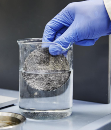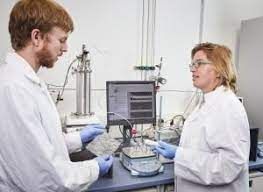Karlsruher Institute For Technology: Water Treatment: Use Sunlight To Eliminate Hormones
Published on by Trudi Schifter, CEO and Founder AquaSPE in Technology
Micropollutants such as steroid hormones pollute drinking water around the world and, even in the smallest quantities, pose a considerable risk to human health and the environment. Well-scalable technologies for water treatment that remove it efficiently and in a sustainable way have so far been missing. Scientists at the Karlsruhe Institute of Technology (KIT) have developed a new chemical process for eliminating the hormones. It makes use of the mechanisms of photocatalysis and converts the pollutants into potentially safe oxidation products. The team reports on this in the journal Applied Catalysis B: Environmental.
Organic pollutants – pharmaceuticals, pesticides and hormones – already contaminate drinking water in a concentration in the nano range in such a way that considerable risks arise for people, animals and the environment. The steroid hormones estrone, estradiol, progesterone and testosterone in particular can cause biological damage in humans and wild animals. For this reason, the European Union has set strict minimum quality standards for perfect and clean drinking water, which the development of new technologies for water treatment must also take into account. “The challenge for science is to develop more sensitive methods to attack the hormone molecules,” says Professor Andrea Iris Schäfer, head of the Institute for Advanced Membrane Technology (IAMT) at KIT. The main issue: Steroid hormones are very difficult to detect in water. “For every trillion water molecules there is one hormone molecule. That is an extremely low concentration, ”explains the expert.
Detecting micropollutants – and removing them
 With conventional water treatment technologies, sewage treatment plants can neither find nor remove the micropollutants. Researchers at the IAMT and the Institute for Microstructure Technology (IMT) at KIT are therefore working on new methods with which they can not only detect and measure micropollutants, but also remove them. A new, photocatalytic process is proving to be promising. The scientists coat a commercially available large-pored polymer membrane with Pd (II) porphyrin, a light-sensitive molecule that contains palladium and can absorb visible rays. Irradiation with simulated sunlight sets a chemical process in motion that creates so-called singlet oxygen, a highly reactive oxygen species. The singlet oxygen “attacks” the hormone molecules in a targeted manner and converts them into potentially safe oxidation products. “It is crucial that we coat the surface of each individual pore with the photosensitizer molecule and thus enlarge the target area,” explains Roman Lyubimenko, scientist at the IAMT and IMT.
With conventional water treatment technologies, sewage treatment plants can neither find nor remove the micropollutants. Researchers at the IAMT and the Institute for Microstructure Technology (IMT) at KIT are therefore working on new methods with which they can not only detect and measure micropollutants, but also remove them. A new, photocatalytic process is proving to be promising. The scientists coat a commercially available large-pored polymer membrane with Pd (II) porphyrin, a light-sensitive molecule that contains palladium and can absorb visible rays. Irradiation with simulated sunlight sets a chemical process in motion that creates so-called singlet oxygen, a highly reactive oxygen species. The singlet oxygen “attacks” the hormone molecules in a targeted manner and converts them into potentially safe oxidation products. “It is crucial that we coat the surface of each individual pore with the photosensitizer molecule and thus enlarge the target area,” explains Roman Lyubimenko, scientist at the IAMT and IMT.
KIT researchers have developed a new process to remove micropollutants using a photocatalytic membrane and visible light. (Photo: Markus Breig, KIT)
 KIT researchers have developed a new process
KIT researchers have developed a new process
to remove micropollutants using a photocatalytic membrane and visible light. (Photo: Markus Breig, KIT)
The concentration of estradiol could be significantly reduced
The chemical breakdown of steroid hormones and the filtration of other micropollutants can be implemented in one module. The process enables the filtration of 60 to 600 liters of water per square meter of membrane in one hour. The scientists are able to reduce the concentration of estradiol, the most biologically active steroid hormone, by 98 percent from 100 to 2 nanograms per liter. “This brings us very close to the EU target of one nanogram per liter,” emphasizes Schäfer. The aim of the research team is now to further optimize the photocatalytic process and transfer it to a larger scale.
Taxonomy
- Micropollutants